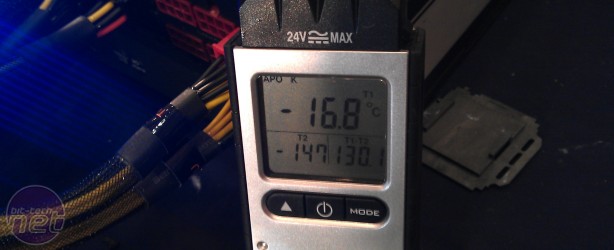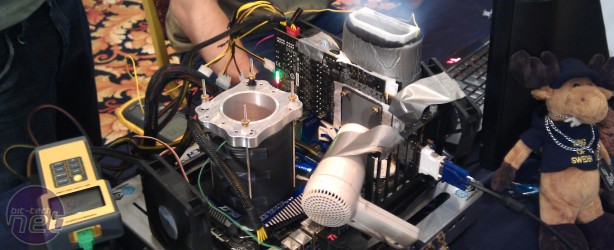
Extreme Overclocking Competitions
bit-tech: You both take it very seriously, then? It’s not just a holiday over here for you guys?Tom Rawes: Well, there are a lot of people following our progress from back in the UK, so we’re trying to our best for them. It’s always in the back of your mind that you’re actually representing your country too. I’m sure there are also a lot of people who would like to be here in our place, so there's a lot of pressure to perform, which really drives you to do your best.
BT: How do you deal with the fact that the results at these events can sometimes simply come down to who has the best components from the start - is that simply part of overclocking, or is that something event organisers should be trying to remove?
TR: It’s a bit of both really - you can’t have it only one way or another. For this event, for example, they sent out the motherboard and graphics card early, which was a good way of allowing us to get used to the kit - you can come to the event and say: 'I know this board isn’t good; I’ll use the replacement,' for example. The processors are the biggest problem, though, and in an ideal world they should bin them before the event. It’s impossible to say exactly what a chip is capable of, of course. They can’t make them all exactly the same, but it’s just nice to know that it is worth persevering with a chip because it’s known that it can go further.
Eddie Coyle: It’s always going to be a lottery at an event like this, but if they bin them then at least you know what to expect from them. I’m not having a go at MSI here, by the way - this was one of the best-organised events I’ve been too - it’s just a little frustrating.
BT: The teams competed with X58 systems at the American MOA finals. Would you prefer to have been overclocking such systems X58 systems here?
TR: Well, you get a lot more variability with Sandy Bridge processors, and it’s seen as more of a newbie overclocking platform than X58. You only have to play with the multiplier really, so there is a lot less stuff you can do with it; overclocking X58 under LN2 is much more of a skill.
EC: Yeah, we’ve lost the base clock overclocking on Sandy Bridge, so you’re stuck with the multiplier overclocking. It’s a younger socket too, so it’s not as well tested as X58.
BT: One thing that’s intrigued us while we’ve been here is the fact that overclocking seems to be a team sport. Why is this? Do you have different expertise in a team?
EC: Well there's just a need for four hands a lot of the time - someone needs to be messing in the BIOS while someone else tops up the pots. In this case, it was Tom playing in the BIOS as he’s had the time with the board - we live miles apart, so I wasn’t able to get to see it before the event. I did have some input, though, if he needed some new ideas or tweaks along the way.
TR: Some of the more elite teams and forums can actually put a team together for its individual skills, though. You might have one guy who specialises in volt modding, and the other guy may be very good at tuning the BIOS and OS to a certain application. They’ll even try and put a team together from their members for a specific competition, depending on the hardware being used in it.
BT: Okay, one final question - what do you guys run at home on a day-to-day basis?
EC: I have a water-cooled Intel Core 2 E8400 running at 4.5GHz, which I use for folding and internet browsing. I also have an LGA1156 setup purely for tweaking and playing with, which I have set up for dry ice. I’ve also built PCs for my sons, one of which runs a Q9550 and the other a Q6600, although neither of them are overclocked at present.
TR: I’ve got three PCs at home, and I can’t stand the idea of them not being overclocked - even the missus’ PC is overclocked. My personal PC is build around an Intel Core i7-2600K running at 5GHz on a quad radiator. I have a second one too for just casual internet browsing, which runs an air-cooled Core i3-540 at 4.6GHz. My missus uses an Intel Core 2 E8500 at 4.2GHz.

MSI MPG Velox 100R Chassis Review
October 14 2021 | 15:04










Want to comment? Please log in.